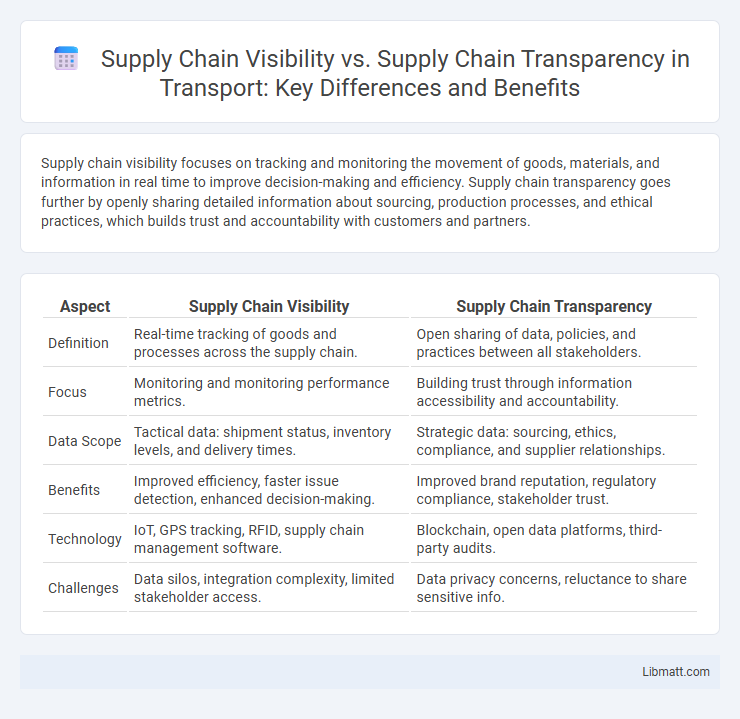Supply chain visibility focuses on tracking and monitoring the movement of goods, materials, and information in real time to improve decision-making and efficiency. Supply chain transparency goes further by openly sharing detailed information about sourcing, production processes, and ethical practices, which builds trust and accountability with customers and partners.
Table of Comparison
| Aspect | Supply Chain Visibility | Supply Chain Transparency |
|---|---|---|
| Definition | Real-time tracking of goods and processes across the supply chain. | Open sharing of data, policies, and practices between all stakeholders. |
| Focus | Monitoring and monitoring performance metrics. | Building trust through information accessibility and accountability. |
| Data Scope | Tactical data: shipment status, inventory levels, and delivery times. | Strategic data: sourcing, ethics, compliance, and supplier relationships. |
| Benefits | Improved efficiency, faster issue detection, enhanced decision-making. | Improved brand reputation, regulatory compliance, stakeholder trust. |
| Technology | IoT, GPS tracking, RFID, supply chain management software. | Blockchain, open data platforms, third-party audits. |
| Challenges | Data silos, integration complexity, limited stakeholder access. | Data privacy concerns, reluctance to share sensitive info. |
Introduction: Defining Supply Chain Visibility and Transparency
Supply chain visibility refers to the real-time tracking and monitoring of goods, inventory, and shipments across the supply network, enabling data-driven decision-making. Supply chain transparency involves the open sharing of detailed information about sourcing, production processes, and ethical practices with stakeholders and customers. Enhancing your supply chain visibility supports operational efficiency, while transparency builds trust and accountability throughout the supply chain ecosystem.
Key Differences Between Visibility and Transparency
Supply chain visibility refers to the ability to track and monitor the movement of goods and information in real-time across the supply chain, providing detailed insights into inventory levels, shipment status, and operational processes. Supply chain transparency goes beyond visibility by promoting open sharing of information among all stakeholders, ensuring ethical sourcing, compliance, and sustainability practices are visible and verifiable. Your supply chain can benefit from enhanced transparency, which builds trust and accountability, while visibility improves operational efficiency and responsiveness.
Importance of Visibility in Modern Supply Chains
Supply chain visibility provides real-time access to data across all stages of the supply chain, enabling companies to respond promptly to disruptions and optimize inventory management. Enhanced visibility supports accurate demand forecasting and improves supplier collaboration, reducing lead times and costs. In contrast, supply chain transparency emphasizes openness and information sharing but relies on the foundational visibility to deliver actionable insights in modern supply chains.
The Role of Transparency in Building Trust
Supply chain transparency involves openly sharing detailed information about sourcing, production, and distribution processes, fostering accountability and ethical practices. This openness enables stakeholders to verify claims, ensuring Your partners and customers can trust the integrity of the supply chain. Enhanced transparency directly supports stronger relationships and reputation by reducing risks linked to hidden practices and misinformation.
Technologies Driving Supply Chain Visibility
Technologies driving supply chain visibility include IoT sensors, AI-powered analytics, and blockchain, which enable real-time tracking and data sharing across all stages of the supply chain. These tools provide granular insights into inventory levels, shipment statuses, and potential disruptions, enhancing decision-making and operational efficiency. Your business can leverage these innovations to achieve comprehensive supply chain visibility, distinct from transparency, which emphasizes open communication and information trustworthiness.
Transparency and Regulatory Compliance
Supply chain transparency ensures open access to information about sourcing, production, and distribution, which is critical for meeting increasing regulatory compliance requirements. Visibility provides real-time tracking and monitoring of goods but may lack the depth of detailed data needed for regulatory audits and ethical standards enforcement. Your commitment to transparency helps build trust with regulators and stakeholders by demonstrating accountability and adherence to legal mandates.
Benefits of Enhanced Visibility vs. Transparency
Enhanced supply chain visibility improves real-time tracking, enabling faster response to disruptions and better inventory management, which reduces costs and increases efficiency. Supply chain transparency builds trust among stakeholders by providing clear, accessible information about sourcing, production, and ethical practices, boosting brand reputation and customer loyalty. Your business gains operational control with visibility, while transparency fosters accountability and long-term stakeholder engagement.
Challenges in Achieving Full Supply Chain Transparency
Achieving full supply chain transparency faces challenges such as data fragmentation across multiple vendors, lack of standardized reporting systems, and limited real-time tracking capabilities. Supply chain visibility often improves through technology integration like IoT and blockchain, but transparency requires deeper access to sensitive information and supplier practices that many companies hesitate to share. These obstacles hinder comprehensive risk management and inhibit stakeholders' ability to ensure ethical sourcing and compliance.
Integrating Visibility and Transparency for Competitive Advantage
Integrating supply chain visibility and transparency enhances your ability to track real-time data and share accurate information across all stakeholders, driving informed decision-making and reducing risks. Visibility focuses on internal monitoring of processes, while transparency extends to openly communicating practices, sourcing, and performance externally. Combining both enables companies to build trust, improve compliance, and achieve a sustainable competitive advantage in increasingly complex global markets.
Future Trends in Supply Chain Visibility and Transparency
Future trends in supply chain visibility include the adoption of advanced technologies such as AI, IoT, and blockchain to enhance real-time tracking, predictive analytics, and end-to-end process monitoring. Supply chain transparency is increasingly driven by regulatory requirements and consumer demand for ethical sourcing, pushing companies to disclose detailed information about suppliers, sustainability practices, and risk management. Your business can leverage these innovations to improve decision-making, build trust with stakeholders, and gain a competitive edge in an evolving global market.
supply chain visibility vs supply chain transparency Infographic

 libmatt.com
libmatt.com